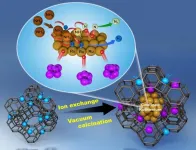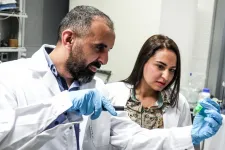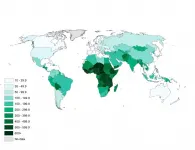Ammonia decomposition for hydrogen economy, improvement in hydrogen extraction efficiency
Development of a zeolite-based nanocatalyst for extraction of hydrogen stored in ammonia; development of a platform for commercializing ammonia as a means of large-capacity hydrogen transport
2021-04-06
(Press-News.org) For the implementation of the effective hydrogen economy in the forthcoming years, hydrogen produced from sources like coal and petroleum must be transported from its production sites to the end user often over long distances and to achieve successful hydrogen trade between countries. Drs. Hyuntae Sohn and Changwon Yoon and their team at the Center for Hydrogen-fuel Cell Research of the Korea Institute of Science and Technology (KIST) have announced a novel nanometal catalyst, constituting 60% less *ruthenium (Ru), an expensive precious metal used to extract hydrogen via ammonia decomposition.
*Ruthenium is a metal with the atomic number 44, and is a hard, expensive, silvery-white member of the platinum group of elements.
Ammonia has recently emerged as a liquid storage and transport medium that has shown promising stability for long-distance hydrogen transport. At 108 kg H2/m3, liquefied ammonia (NH3) can store 50% more hydrogen than liquid hydrogen. When ammonia is decomposed at high temperatures, only hydrogen and nitrogen gases are produced, with minimal carbon dioxide emissions. Because over 200 million tons of ammonia is currently produced annually for industrial use around the globe, the infrastructure for its mass storage and long-distance transport already exists and can simply be re-purposed for hydrogen transport.
The need for a lot of heat has been a pressing issue thwarting the widespread adoption of ammonia for use in hydrogen transport and storage, however. The decomposition reaction through which hydrogen is extracted from ammonia can only proceed at high temperaturewhich requires high energy input. A catalyst in the form of a solid powder can be added during the decomposition reaction to lower the reaction temperature; however, the existing ruthenium-metal-based catalysts are very expensive and have low stability, thus requiring regular replacement.
The KIST research team has developed a catalyst for hydrogen production from ammonia decomposition in which ruthenium metal particles and **zeolite are strongly bound by calcination under vacuum, which results in the containment of sub-nanometer and nanometer (one billionth of a meter) ruthenium metal particles in each pore of the zeolite support. This novel catalyst exhibits 2.5-times higher ammonia decomposition performance than conventional commercial catalysts and achieves this efficiency while using only 40% of ruthenium metal. Because nanometer-sized (or smaller) ruthenium metal particles are present and maintain their stability during the ammonia decomposition process even at high reaction temperatures, the use of the proposed catalyst can overcome the problem of low stability, which has been significantly limiting the commercialization of existing catalysts.
** Zeolite is a mixed oxide of silicon and aluminum, which is a type of crystalline mineral connected by nanometer-level pores. It is often used as a catalyst support and exists in a structure in which pores having the size on the order of several nanometers to tens of nanometers are connected, depending on the type.
"The developed catalyst has an advantageous structure in that the nanometer-sized ruthenium metal particles are uniformly spread over zeolite, a crystalline mineral. Thus, this catalyst has shown higher performance and stability than previously reported catalysts and is expected to facilitate the commercialization of the process for high-purity hydrogen production from ammonia," said Dr. Hyuntae Sohn, KIST. "The importance of large-capacity hydrogen transport based on ammonia is rapidly increasing, with fierce competition among advanced countries over the development and acquisition of related technologies. The application of the proposed catalyst for large-capacity hydrogen production via ammonia decomposition, which is currently under research and development, will ultimately help the commercialization of ammonia-derived hydrogen and the large-capacity hydrogen transportation between countries," said Dr. Changwon Yoon.
INFORMATION:
This research was supported by the New & Renewable Energy Core Technology Program of the Korea Institute of Energy Technology Evaluation and Planning(KETEP), granted financial resources by the Ministry of Trade, Industry & Energy (MOTIE). The results of this study were published in the latest issue of "Applied Catalysis B: Environmental", an international journal in the field of energy and the environment.
[Attachments] See images for this press release:

ELSE PRESS RELEASES FROM THIS DATE:
2021-04-06
Epidemiological studies have found that transportation noise increases the risk of cardiovascular morbidity and mortality, with high-quality evidence for ischaemic heart disease. According to the WHO, ?1.6 million healthy life-years are lost annually from traffic-related noise in Western Europe. Traffic noise at night causes fragmentation and shortening of sleep, elevation of stress hormone levels, and increased oxidative stress in the vasculature and the brain. These factors can promote vascular dysfunction, inflammation and hypertension, thereby elevating the risk of cardiovascular ...
2021-04-06
Humans have altered the ocean soundscape by drowning out natural noises relied upon by many marine animals, from shrimp to sharks.
Sound travels fast and far in water, and sea creatures use sound to communicate, navigate, hunt, hide and mate. Since the industrial revolution, humans have introduced their own underwater cacophony from shipping vessels, seismic surveys searching for oil and gas, sonar mapping of the ocean floor, coastal construction and wind farms. Global warming could further alter the ocean soundscape as the melting Arctic opens up more ...
2021-04-06
The world's first ground-based observations of the bare nucleus of a comet nearing the end of its active life revealed that the nucleus has a diameter of 800 meters and is covered with large grains of phyllosilicate; on Earth large grains of phyllosilicate are commonly available as talcum powder. This discovery provides clues to piece together the history of how this comet evolved into its current burnt-out state.
Comet nuclei are difficult to observe because when they enter the inner Solar System, where they are easy to observe from Earth, they heat up and release gas and dust which ...
2021-04-06
April 06, 2020-- A new commentary published online in the Annals of the American Thoracic Society provides an exhaustive examination of published research that discusses whether air pollution may be linked to worse COVID-19 outcomes. The studies that the authors examined look at several potential disease mechanisms, and also at the relationship between pollution, respiratory viruses and health disparities.
In "COVID-19 Pandemic: A Wake-Up Call for Clean Air," Stephen Andrew Mein, MD, Department of Medicine, Beth Israel Deaconess Medical Center, Boston, and colleagues ...
2021-04-06
A University of Guam review of published research on the critically endangered Serianthes nelsonii tree has revealed a reason why the population of the trees continues to be endangered despite a long history of funded conservation projects and a national recovery plan implemented 26 years ago. The review article, co-authored by biologists of the Plant Physiology Laboratory of UOG's Western Pacific Tropical Research Center, was published on March 2 in Horticulturae journal (doi:10.3390/horticulturae7030043).
"A main message of our paper is that decision-makers from funding agencies limit conservation success when practitioners ...
2021-04-06
A revolutionary technology developed within the END ...
2021-04-06
WASHINGTON, April 6, 2021 -- Home brewing enthusiasts and major manufacturers alike experience the same result of the beer-making process: mounds of leftover grain. Once all the flavor has been extracted from barley and other grains, what's left is a protein- and fiber-rich powder that is typically used in cattle feed or put in landfills. Today, scientists report a new way to extract the protein and fiber from brewer's spent grain and use it to create new types of protein sources, biofuels and more.
The researchers will present their results today at the spring meeting of the American Chemical Society (ACS). ACS Spring 2021 is being held online April 5-30. Live sessions will be hosted April 5-16, ...
2021-04-06
By 2050 global warming could reduce crop yields by one-third. UC Riverside researchers have identified a gene that could put the genie back in the bottle.
Warmer temperatures signal to plants that summer is coming. Anticipating less water, they flower early then lack the energy to produce more seeds, so crop yields are lower. This is problematic as the world's population is expected to balloon to 10 billion, with much less food to eat.
"We need plants that can endure warmer temperatures, have a longer time to flower and a longer growth period," said UCR botany and plant sciences professor ...
2021-04-06
DALLAS, April 6, 2021 -- A tsunami of chronic health conditions as a result of the SARS-CoV-2 pandemic, especially cardiometabolic disease, may produce an enormous wave of death and disability that demands immediate, comprehensive strategies. In addition, COVID-19 has disrupted cardiovascular science and medicine, yet it presents opportunities to transform and create novel approaches that can yield new successes. These are the opinions of two esteemed leaders in cardiovascular disease care, research and strategy, detailed in two new Frame of Reference articles published today in the American Heart Association's flagship journal Circulation.
While COVID-19 has severely impacted everyone's daily lives, its societal ...
2021-04-06
The inequality is enormous: Mothers in select African countries are more than 100 times more likely to have had a child die than mothers in high-income countries.
This is what Diego Alburez-Gutierrez (Researcher at the Max Planck Institute for Demographic Research (MPIDR) in Rostock, Germany), Emily Smith-Greenaway (Researcher at the USC Dornsife College of Letters, Arts and Sciences in Los Angeles and Guest Researcher at MPIDR), and co-authors found in their recent paper published in BMJ Global Health.
"We offer the first global estimates of the cumulative number of child deaths experienced by mothers ...
LAST 30 PRESS RELEASES:
[Press-News.org] Ammonia decomposition for hydrogen economy, improvement in hydrogen extraction efficiency
Development of a zeolite-based nanocatalyst for extraction of hydrogen stored in ammonia; development of a platform for commercializing ammonia as a means of large-capacity hydrogen transport







